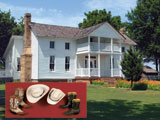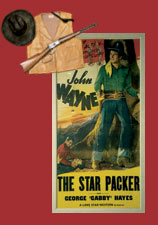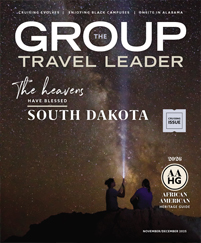Will Rogers, the most famous man ever to come from Oklahoma, was both a cowboy and an Indian.
Popular history likes to boil down the story of the West to simple terms, but the reality is often much more nuanced and complex. In Oklahoma, history includes Indians, cowboys and the cavalry, all intersecting in ways that go beyond a simple storyboard.
At historic sites and modern attractions throughout the state, visitors can learn about groups that defined the Old West and some of the more recent performers that helped to make it legendary.
Will Rogers Memorial Museums
Oologah and Claremore
Oklahomans are understandably proud of Will Rogers, the cowboy, actor, writer and entertainer who was one of the most famous men in the country during the early 20th century. Local Cherokee are proud of him too, because Rogers was one-quarter Cherokee.
 |
| Groups can arrange to visit Will Rogers’ mausoleum at the Will Rogers Memorial Museum in Claremore. Courtesy Will Rogers Memorial Museums |
“He would talk about his Cherokee heritage,” said Steve Gragert, director of the Will Rogers Memorial Museums. “In the 1920s and 1930s that was uncommon.”
Visitors can learn more about Rogers’ life and career at two sites: the Will Rogers Birthplace Ranch in Oologah and the Will Rogers Museum in Claremore. At the birthplace, they can walk through the house where Rogers was born and spent much of his childhood. The working ranch also has a number of animals, such as chickens, goats and peacocks, similar to the ones that Rogers’ family raised.
The Will Rogers Memorial Museum is a large institution that details Rogers’ life and work. The museum’s displays feature numerous writing samples, film clips and artifacts from his career and personal life.
“Many of the items in the museum are from Will’s personal collection,” Gragert said. “The family donated many of his artworks and other things to the museum.”
Galleries at the museum deal with Rogers’ Cherokee heritage, his skills as a roper and cowboy, and his illustrious Hollywood career. Groups can watch full-length films in the theater or arrange to visit the star’s mausoleum at the site, which is normally closed to the public.
www.willrogers.com
Osage heritage
Pawhuska
In northeastern Oklahoma, Osage County is home to many members of the Osage Nation, Native Americans with a long history in the region. Oklahoma tribes aren’t confined to reservations. . In the small town of Pawhuska, visitors can learn about the area’s Osage heritage and visit the tribal headquarters.
The tribal headquarters is the seat of the Osage Nation’s government and legislature. Groups can tour the legislative building and visit the adjacent museum, which details the tribe’s history.
“This was the first tribally owned museum in the United States,” said the museum’s Rhonda Kohnle.
The museum includes artifacts such as tools, clothing, beads and ceremonial items, some going back to prehistoric times. One highlight is an exhibit of the traditional wedding outfit worn by young women that includes military coats, skirts and top hats adorned with feathers.
 |
| Groups can visit the house where Will Rogers was born near Oologah. Inset, some of Rogers’ boots and cowboy hats are on display at the National Cowboy and Western Heritage Museum in Oklahoma City. Top, courtesy Will Rogers Memorial Museums Inset, courtesy The National Cowboy and Western Heritage Museum |
Also in Pawhuska, the Immaculate Conception Catholic Church gives visitors an interesting glimpse into local culture. Known to many as the Cathedral of the Osage, this church is decorated with native designs and has stained-glass windows depicting some of the church’s earliest Osage members.
By working in advance with the Pawhuska Chamber of Commerce, groups can arrange to have an Osage feast prepared by locals. The traditional meal features fry bread, corn soup, grape dumplings and meat gravy.
Fort Gibson Historic Site
Fort Gibson
The oldest town in Oklahoma, Fort Gibson was established in 1824 as a military outpost to help keep peace between the Osage, white settlers and the five other Native American tribes that were relocated to the territory. Today, visitors can tour a replica of the original fort to learn more about life during that period.
The replica fort has been built to scale with original materials and includes rooms such as an armory, soldiers’ barracks, a jail, a commissary and a carpenter’s shop.
The fort is also significant as the first station of the Buffalo Soldiers in the state of Oklahoma. When groups visit, they can meet a historic re-enactor, who tells them about the Buffalo Soldiers and does a “show and tell” of a soldier’s knapsack. The items include travel-size silverware, tooth powder — a predecessor to toothpaste — and hog’s hair toothbrushes.
Also at Fort Gibson are a historic museum and a period vegetable garden.
National Cowboy and Western Heritage Museum
Oklahoma City
For fans of cowboy
 |
| The National Cowboy and Western Heritage Museum in Oklahoma City has several John Wayne artifacts, including some of the clothing he wore in his Academy Award-winning role in True Grit. Courtesy The National Cowboy and Western Heritage Museum |
and Western art and artifacts, there’s no missing the National Cowboy and Western Heritage Museum in Oklahoma City. This massive museum is full of all kinds of art and memorabilia, from paintings and larger-than-life sculptures to costumes worn in Hollywood Western films.
One highlight of the museum is the Western Performers Gallery, which honors Western movie stars such as Tom Selleck, Slim Pickens and the legendary John Wayne.
“We have the pistol from the last movie John Wayne was in, The Shootist,” said Aaron Martin, director of tourism marketing at the museum. “We also have a number of his guns and knives.”
Another major component of the museum is Prosperity Junction, an early-20th-century town that has been re-created inside the museum. The town features 19 buildings built to scale in amazing detail. Many of the building interiors are outfitted with antique items and historic artifacts.










